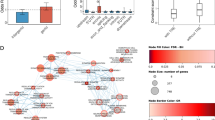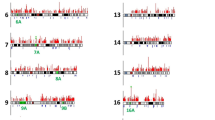Abstract
An association between bipolar affective disorder and CAG/CTG trinucleotide repeat expansions (TRE) has previously been detected using the repeat expansion detection (RED) method. Here we report that 89% of RED products (CAG/CTG repeats) >120 nt (n = 202) detected in affective disorder patients as well as unaffected family members and controls correlate with expansions at two repeat loci, ERDA1 on chromosome 17q21.3 and CTG18.1 on 18q21.1. In a set of patients and controls in which we had previously found a significant difference in RED size distribution, the frequency of expansions at the CTG18.1 locus was 13% in bipolar patients (n = 60) and 5% in controls (n = 114) (P < 0.07) with a significantly different size distribution (P < 0.03). a second set of patients were ascertained from 14 affective disorder families showing anticipation. twelve of the families had members with red products >120 nt. The RED product distribution was significantly different (P < 0.0007) between affected (n = 53) and unaffected (n = 123) offspring. Using PCR, a higher frequency (P < 0.04) of ctg18.1 expansions as well as a different (P < 0.02) repeat size distribution was seen between affected and unaffected offspring. in addition, a negative correlation between red product size and the age-of-onset could be seen in affected offspring (rs = −0.3, P = 0.05, n = 43). This effect was due to an earlier onset in individuals with long CTG18.1 expansions. No difference in ERDA1 expansion frequency was seen either between bipolar patients (35%, n = 60) and matched controls (29%, n = 114), or between affected and unaffected offspring in the families. We conclude that expanded alleles at the CTG18.1 locus confers an odds ratio of 2.6–2.8 and may thus act as a vulnerability factor for affective disorder, while the ERDA1 locus seems unrelated to disease.
This is a preview of subscription content, access via your institution
Access options
Subscribe to this journal
Receive 12 print issues and online access
$259.00 per year
only $21.58 per issue
Buy this article
- Purchase on Springer Link
- Instant access to full article PDF
Prices may be subject to local taxes which are calculated during checkout
Similar content being viewed by others
Author information
Authors and Affiliations
Corresponding author
Rights and permissions
About this article
Cite this article
Lindblad, K., Nylander, PO., Zander, C. et al. Two commonly expanded CAG/CTG repeat loci: involvement in affective disorders?. Mol Psychiatry 3, 405–410 (1998). https://doi.org/10.1038/sj.mp.4000416
Received:
Revised:
Accepted:
Published:
Issue Date:
DOI: https://doi.org/10.1038/sj.mp.4000416
Keywords
This article is cited by
-
Association between COMT (Val158Met) functional polymorphism and early onset in patients with major depressive disorder in a European multicenter genetic association study
Molecular Psychiatry (2005)
-
A novel CpG-associated brain-expressed candidate gene for chromosome 18q-linked bipolar disorder
Molecular Psychiatry (2003)
-
European combined analysis of the CTG18.1 and the ERDA1 CAG/CTG repeats in bipolar disorder
European Journal of Human Genetics (2002)
-
Manic-depression genes and the new millennium: poised for discovery
Molecular Psychiatry (2002)
-
Triplet repeats and bipolar disorder
Current Psychiatry Reports (2002)



